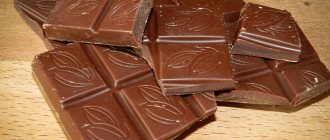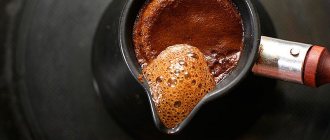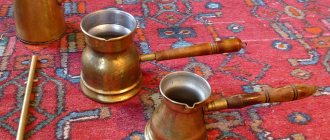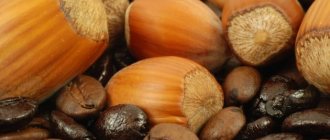Making coffee
1 comment
Good day, site readers! Turkish coffee is unlike any of the coffee delicacies that gourmets love so much. It has a unique taste, delicious aroma and delicate foam.
Its preparation and method of serving is a special ritual. The drink is known all over the world and is beloved by true gourmets. One cup contains several flavors at once, from sweet to bitter, very thick. The Turkish coffee recipe is quite simple and does not require knowledge of a special recipe or attention during preparation.
The appearance of this delicacy in Turkey dates back to the Ottoman Empire of the 16th century. It was around this time that the first coffee shops appeared, where you could enjoy an invigorating delicacy. It was from then on that eating delicacies became a real ritual. It is worth noting here that it was from Turkey that fortune telling on coffee grounds came to us.
There is another story about the origin of the drink: caravan workers from Asia and Africa learned to prepare it, and only then did it come to Turkey. Due to the fact that the delicacy has gained enormous popularity in Turkey, that is why it is called Turkish coffee. It was here that such a device as the Turkish coffee pot was invented.
Turkish drink review
Turkish coffee is the national drink of Turkey, which has gained worldwide popularity thanks to its exquisite taste and fantastic aroma. Basically, Turkish coffee is prepared according to a recipe that is easy to prepare, but at the same time has its own secrets and important nuances.
Turkish coffee first appeared in the 16th century under Sultan Suleiman the Magnificent and was served only in the highest circles of the nobility. Later, the first coffee shops began to appear in 1564 in the city of Istanbul. There are many rituals and traditions associated with coffee in Turkey. Drinking coffee together was considered a sign of respect and friendship. Coffee houses were where people liked to spend time during the day socializing, playing chess, discussing politics, etc.
Vessel selection
The most important thing when choosing a Turk is the conical shape and small volume of the container. The most common type of Turk for making coffee is the metal Turk.
This Turk is very easy to use, durable and easy to handle. Metal Turks are made of aluminum, silver, copper and stainless steel.
Among these four types of material, stainless steel and aluminum pots are the worst options to purchase, as the coffee in them will be worse in taste and consistency.
Silver and copper Turks are the best options for both the aesthetic and functional aspects of making Turkish coffee. However, the best coffee is obtained from a copper pot.
Due to the fact that copper has high thermal conductivity, the Turk heats up evenly and this contributes to the correct technology for preparing the drink. At the same time, it is necessary that the bottom of the Turk be covered with tin, because copper can release substances harmful to the human body.
In addition to metal ones, there are other types of Turks that are less commonly found on sale, but are also traditionally used for making Turkish coffee. For example, ceramic Turks are characterized by thick walls that retain heat and are of good quality.
When buying a Turk, the professional advice in the video will help you:
How to choose coffee?
The best type of coffee is Brazilian Arabica. You need to buy coffee in beans and grind it yourself before the brewing process as finely as possible, literally into dust.
There is also Luwak coffee, a very specific coffee according to the method of its preparation, which is very original, but at the same time recognized as the most expensive and delicious type of coffee in the world.
What types of coffee are there and how to choose the right one, you will learn from the video:
How much water do you pour?
Cold drinking water is poured to the level of the neck of the Turks. It is necessary to achieve minimal contact with air to fully saturate the drink with the aroma and taste of coffee beans.
The smell and taste of happiness. Caribbean coffee
Spices, orange zest and the anticipation of happiness... Coffee promises it, a sip of which - thick and sweet - tells you that it is very close.
Required ingredients include:
- orange zest, you can also take the pulp
- good quality cinnamon
- cloves, ground or whole, finely chopped
- vanilla sugar
- If desired, you can add star anise.
Making coffee the Caribbean way
Scald the orange with boiling water, grate the zest and also the pulp. Add sugar, ground coffee, cinnamon, cloves and star anise to them. Pour in cold water and put on low heat.
When the foam starts to rise, remove from heat. We return the Turk to the stove and do this two or three more times.
Natural vanilla extract will bring your Caribbean coffee very close to the authentic version.
Choosing a variety
We recommend using Arabica Brazil Santos with its most typical flavor so that it does not interfere with additives. This is a coffee classic, descended about 200 years ago from the ancient Coffee Arabica, which arrived from Yemen.
It will also be interesting to try Arabica Sumatra Mandeling from the island of the same name. Chocolate, caramel, spices seasoned with smoke from the fire intertwine here and form a unique range of taste. The taste is balanced, rich, without sourness.
How to cook in a Turk?
Mehmet Efendi is a large Turkish coffee producer with a famous name and rich history. How to brew Turkish coffee in a Turk - is it a vessel in which Turkish coffee is brewed? To prepare Turkish coffee in a Turk according to Mehmet Efend's recipe, you will need the following.
- water 150 ml.
- ground coffee 2 tsp.
- sugar to taste
Cooking method:
- Pour all the ingredients into the Turk. Brew coffee over low heat, stirring constantly.
- After raising the coffee level a second time, you can divide it into two halves and pour ½ of the drink into a coffee cup.
- The second half needs to be cooked for another half a minute and poured into a cup along with the coffee grounds. In half a minute the grounds will settle.
- Traditionally, Turkish coffee is served with a glass of water.
How to brew coffee according to Mehmet Efendi’s recipe, watch the video:
Arabic traditions
Many people associate Arabic coffee with the Mocha variety. It got its name from a port in Yemen. Elite coffee grown in the lands of Arabia was exported through it. The process continued until the end of the 19th century. Guests of the country were strictly forbidden to visit the plantations, and theft of sprouts was punishable by death.
Another historical fact: in the beginning, in Arab countries, coffee was brewed from husks, and the beans were simply thrown away. The drink is still prepared in Yemen, and its characteristics are very different from traditional coffee.
In Eastern culture, coffee is consumed in small sips. Without a drink, no conversation takes place. It can take about 40 minutes to drink one cup.
General Tips
- Follow the grinding technology. If the coffee grinder is used incorrectly, grinding the beans for too long can cause overheating, causing the taste to deteriorate.
- Store coffee in a dry, airtight container.
- Take out the coffee only with a dry, clean spoon.
- Rinse the Turk thoroughly after washing to avoid any detergent residue.
- Brew coffee strictly before serving, as it can cool and lose its properties, taste and aroma.
- Roasted grains are stored for no more than 2 weeks, since after this period they lose their aroma and flavor richness.
- The foam that appears on the surface of the drink when heated must be intact and without cracks.
- You should not allow the coffee to boil, you just need to wait until the foam rises up to 2 times and then immediately pour it into a cup.
The process of preparing Turkish dishes is not complicated, you will see this if you try to cook dishes such as güvec, babaganush or Turkish eggplant.
For the brave: Coffee with honey and garlic
This coffee is called “Serbian”, “Jewish”, and “the secret of the old Moor”, in general, choose which one you like best. Where the recipe came from is still unknown, and different countries claim authorship, which can be seen from the names.
The drink turns out to be super expressive, but not harsh; honey builds a balance between the tastes of coffee and garlic, combining all components into one harmonious bouquet. Coffee really invigorates and drives away the blues.
So, let's get down to business:
- For 2 teaspoons of freshly ground coffee, take a small clove of garlic and a tablespoon of natural honey. We peel the garlic, cut it lengthwise into halves and remove the core along with the green blade, but you don’t have to cut it, but put it in whole.
- Place the turk on low heat and add ground coffee and garlic. We warm them up for a few seconds and immediately fill them with water at a temperature close to boiling. We are waiting for the foam to appear.
- Remove the Turk from the heat, hold it in the air for 20 seconds, and put it back on the stove until the foam appears for the second time. Important: the coffee should not be allowed to boil.
- Remove the coffee from the heat and let it brew for 1-2 minutes. During this time, it cools down to 60°C, the temperature at which honey retains its beneficial properties.
- Add honey. Do not stir, wait until the honey dissolves on its own.
- Strain the coffee and pour into cups.
Good to drink with dark chocolate or hard cheese.
What varieties?
We suggest using dark roasted Arabica Nicaragua Las Segovia. Very dense coffee with low acidity, rich taste with hints of nuts and cocoa. Long tart aftertaste with notes of spices.
Coffee bushes in Nicaragua grow under the canopy of powerful trees, forming an optimal ecosystem, and this has a beneficial effect on the taste and quality of the crop. Coffee grows at an altitude of more than 1000 meters, selected beans are collected by hand. To preserve antioxidants, the grain is processed in a special way - without exposure to high temperatures. Cleaned grains undergo natural fermentation in water, after which they are dried in the open air.
If you want a softer and spicy taste – “India Plantation”.
Classic Turkish coffee
Turkish choice
If you want to make delicious coffee in a Turkish coffee pot, then copper cookware . Copper has high thermal conductivity, which ensures more even heating of the Turk. This is also facilitated by its shape - widened at the bottom, narrowed at the top. The inside of a copper pot must be coated with tin, since copper tends to oxidize when heated, which is harmful to health. In some cases, instead of tin plating, the Turk is coated with silver - but such Turks are very rare, and they cost accordingly.
A ceramic Turk is also suitable, but keep in mind that it will take quite a long time to cool down, even after removing it from the heat. That is, if you do not do this before foam appears, you risk overcooking the coffee - there will be a burnt tint in the taste and aftertaste. Therefore, it is worth removing a ceramic cezve from the sand a little earlier than a copper one, before foam appears.
If you like a clay Turk , then you can also safely use it to make classic oriental coffee. Its advantages are good thermal conductivity and a lower price than copper. By the way, it takes just as long to cool down as a ceramic pot, so it should also be removed from the sand before foam appears.
When choosing a clay Turk, pay attention: the inside must be glazed, otherwise over time, when used, the dishes will absorb coffee oils and give the drink an unpleasant bitterness.
You should not take an aluminum Turk , as it heats up faster than others. This will cause the ground coffee particles at the bottom of the pan to burn. As a result, the drink will be unpleasantly bitter, and if the cezve is of poor quality, it will also have a metallic taste.
The volume of Turka depends on how many ml of the finished drink you drink. That is, if you drink 250 ml of coffee at a time, then the volume of the cezve should be the same.
It is not advisable to take a Turk of more than 400 ml, since due to the lack of additional movement of water inside, the coffee simply will not boil, which is why the drink will be unsaturated and bland.
Hi all! You have come to my “Turkish” blog, where I share my thoughts, feelings and observations. And now not only about Antalya and Turkey, but also about my life in general. Today we’ll talk about ways to brew Turkish coffee.
Greetings from India. Masala Coffee Recipe.
Here it all began with a legend: an Indian pilgrim, on his way to Mecca, stole seven coffee beans from Yemen and hid them in his clothes. They were brought to the southern state of Cartanaka in the 17th century.
Since then, coffee trees have been growing in the Chandragiri hills of this state. Indians, especially in the south of the country, love coffee; they brew it in their own way, generously enriching it with their usual spices.
Masala is a mixture of spices. The drink is memorable for its rich, creamy coffee taste with a complex aroma. No wonder, because the coffee in this recipe immediately became friends with a whole bunch of spices. A typical Masala has five ingredients: cinnamon, cardamom, cloves, nutmeg, star anise, which are often supplemented with freshly ground black pepper, cumin and ginger.
A prerequisite for a Masala coffee recipe is 2/3 of the liquid base is milk, the remaining third is water.
How to brew Masala coffee in Turkish
- Grind star anise and anise in a mortar, heat the remaining spices in a frying pan.
- Grind the coffee, the grind should be approximately the size of granulated sugar.
- Let's prepare the Turk; in volume it should be about a third larger than the portion that you are going to cook.
- Pour the milk mixture (see above) into the Turk, add sugar, preferably cane sugar, and heat to about 60-70 degrees.
- Add coffee and spices in a 3:1 ratio, mix and heat for 3 minutes over low heat, without bringing to a boil.
- We stop at the moment when the foam just begins to rise, remove from the heat so that the foam settles, repeat this 2-3 times.
- Let it brew and strain.
This coffee is excellent for warming and treating colds, ideal for drinking in chilly climates and during the autumn rains.
What varieties are suitable for Masala coffee?
We recommend using India Plantation dark roast coffee: sweet, with notes of red apple and nuts. Dense, chewy and slightly earthy. Note that it goes well with milk, in almost any coffee drinks.
An alternative could be the Chocolate Express mixture.
Preface
Learn how to make Turkish coffee at home like I learned from my mother. The following post includes step-by-step photos and videos showing you the equipment, ingredients, and preparation techniques needed. As a bonus, I’ll tell you the history of Turkish coffee and fortune telling with it.
- Yield: 2 cups
- Preparation time: 5 minutes
- Cooking time: 10 minutes
My love for coffee comes from my mother.
For her, Turkish coffee was an almost daily ritual to be done with friends and family. It was a way to celebrate her friendships and express gratitude to those she loved.
Although she worked most of her life, on the rare days when she was at home, she invited her friends over for coffee in the morning. Before they arrived, she made me set out two trays: the first with Turkish coffee cups, and the second with water glasses. We always had something sweet to go with our coffee. For example with Turkish delight, but my mother liked to serve it with chocolate.
Before her friends arrived, my job was to prepare and serve coffee. When I greeted them, I asked how they drank their coffee and immediately went to the kitchen to prepare it according to everyone's preferences. It was such a proud moment for my mom when I walked out of the kitchen with a tray in my hand.
When I look back and think about it today, I realize how important it was for her that I understood the tradition behind it. I was very lucky to be allowed to drink coffee at a young age and learned to enjoy it through family tradition.
How to make Turkish coffee
In Turkey, when you go to someone's house, the first question is not whether you would like to drink Turkish coffee, but rather how you would like the coffee to be prepared
Once you have answered, the person preparing the coffee is responsible for preparing it according to individual sugar preferences and preparation methods. Usually this is the youngest girl in the house. As you can imagine, as the only daughter in our family, I have cooked more than my fair share in my life. Therefore, I feel qualified to share my knowledge with you.
How to make Turkish coffee











